Dear Azami,
A while back, my little brother and I showed up to one of our local stores without realizing it was Commander night. Fortunately, one of my friends
happened to be there and offered to lend us some decks so we could stay. We had never played Commander before, but ended up having a blast! We’ve since
both made decks of our own, during which time my brother asked me to help him. Unfortunately, with such limited experience I didn’t really know what to
say. Can you offer some advice?
He seemed to really enjoy the political nature of the format, as well as the absurd or hilarious things you can do in long games with lots of people.
Keeping that in mind, we’re hoping to make a very interactive deck lead by the mighty Phelddagrif! I would like it if the deck could strike a balance
between making crazy scenarios while still giving your opponents some reason to put up with them. Also, the deck should have some way to win – currently
it’s Squirrel Nest + Dryad Arbor + Intruder Alarm for infinite tokens.
My brother is eleven years old, so a $40-$50 budget would be greatly appreciated.
Commander: Phelddagrif
3x Forest
5x Plains
8x Island
– Owen
This looks like the typical “Group Hug” Phelddagrif deck, full of exactly the sorts of cards you’d basically expect to see when someone sat down with this
particular Commander. From the other side of the table, my personal experience has been that they might as well not be there – you can safely ignore them
until the middle stages of the game, and the biggest concern is actually that their cards might turn the more-broken decks at the table into insurmountable
problems. My usual plan against a Phelddagrif is to forget they’re there until you’ve succeeded at taking down the biggest problem, but then they die next
– and usually their defenses are insufficient to stop that from happening, they rely too much on goodwill to keep them at the table.
Goodwill is well and good, but it tends to be unreliable. There’s a careful balance to strive for here – you don’t really want to help your opponents out
too much, so a lot of the Howling Mine-type cards are really problematic here. Frankly, you don’t have the natural defenses it would take to stop a broken
deck that decided to run the table with all of those cards and extra mana you just gave them. Also, I don’t think you want to rely too much on the “Pillow
Fort”-type enchantments, because those are one of the red flags that tell opponents now is the time to take you out while they still can. As to winning the
game, I think the win mechanism for this deck is incredibly loose – Squirrel Nest is not good here without the other two combo pieces, and Dryad Arbor is super fragile and should not be relied upon here. Intruder Alarm might be worthwhile just for the political effect, but giving out free untaps is
just as problematic as the other hugging/sharing cards that enable combinations you can’t stop… you could do it in two cards instead with Squirrel
Nest/Earthcraft and then you wouldn’t have to rely on keeping a 1/1 that is also a nonbasic land in play while you’re trying to pull off the combo; the
third “piece” of the combo is just “any basic land” when you’re playing a reasonably good number of them. I think a more traditional suite of finisher
cards would honestly work better for your brother here, even if they might not be as laugh-out-loud hilarious as assembling an infinite-Squirrel combo, and
they would also come with the benefit of giving the deck more replay value for its opponents – there’s something to be said for finishing the game “fairly”
instead of using a combo to finish a game your opponents have probably spent two hours of back-and-forth playing.
Let’s begin with the mana:
Out:
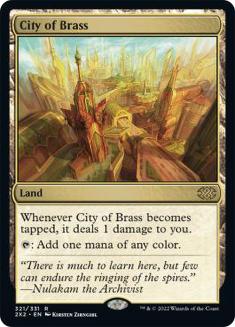
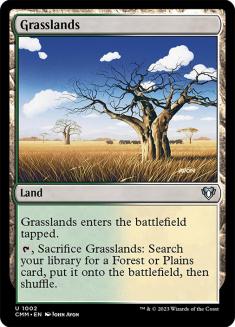
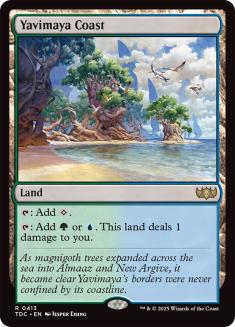
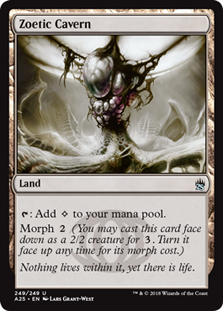
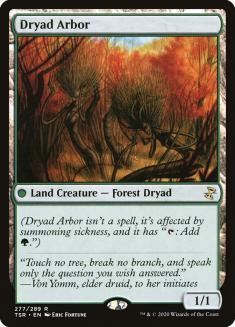
In:
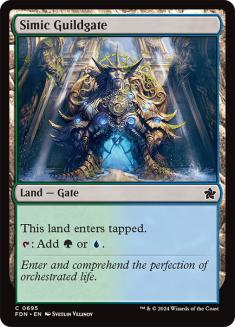
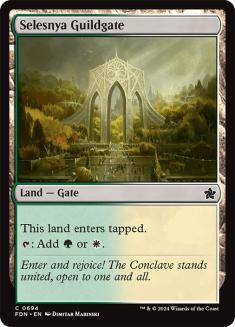
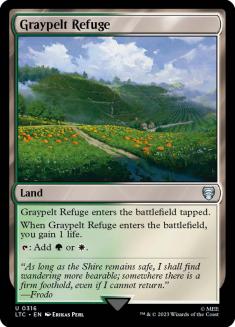
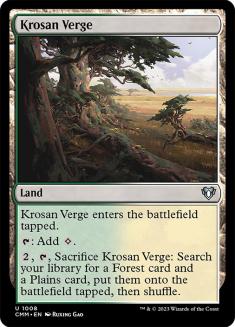
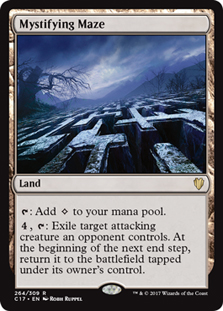
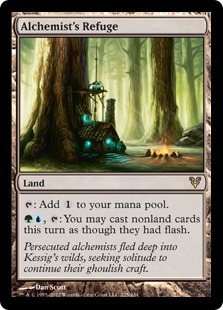
I straight-up added a land to get to 37, largely playing the “cycle-completion game” to fill in the missing holes in cycles of lands you otherwise considered worth playing. Here, that meant Guildgates and their near analogues, because we’re trying to keep the budget down and an expensive manabase would misallocate resources that can be put into more fun things than fancy lands. That said, two of these lands are quite fancy – I am a firm advocate of Lands That Do More Things, and Mystifying Maze adds a strong defensive option without really impacting your manabase like Maze of Ith would. And at just over $1, it has a high bang-to-buck ratio for how the deck will play out, making it quite worthwhile. The last addition, Alchemist’s Refuge, is about one of my favorite things to do in Commander – I’ve been an advocate of Winding Canyons since the start of this article series, and you can do even better than that card if you happen to be both blue and green thanks to the Refuge giving that same power to all of your spells, not just your creatures.
Moving on to the artifacts, we have two cards to take out – Avarice Totem and Howling Mine – and one card to add back in, with the missing slot having gone over to become a land instead. If your brother wasn’t already playing Signets, I’d have suggested that you add all three of them here – when you’re playing a color-intensive four-drop Commander, my appreciation of their value greatly increases. But since they’re already present, and I don’t feel you need to stretch even further to add Fellwar Stone, Coldsteel Heart, or Star Compass to boost that aspect of the deck, I just wanted to meddle with the problematic cards here and add more fun/powerful ones in their stead.
Avarice Totem is cute but only really good when you have ten mana and your opponent doesn’t have five mana, as then you can stack things correctly in order to trade them something irrelevant like a basic land rather than the Totem itself. I suspect your brother is enjoying the part where he gives it to an opponent and it starts making its way around the table causing trouble turn after turn, but as much fun as that may be sometimes, it’s fun that can be easily countered by an opponent either a) refusing to play that game further, accepting their losses and leaving the Totem be, or b) abused by an opponent who knows how to use the double-activation trick to trade their basic lands for someone else’s best stuff once they’ve tapped out. The replay value of this card is quite low, even though the chaotic value can be quite high, and I don’t think it’s really worth a slot here.
Howling Mine and its friends just share too much benefit with your opponents to be worthwhile. We’ve all seen the Hug deck, and we all know the problems it causes, and frankly, I think it’s been done to death, likewise pidgeonholing the deck’s replay value. There are plenty of other ways to have vibrant and exciting games, and we’ll cut these sorts of cards for those sorts of cards pretty much every time we’ll find them.
We’ll take that empty slot and add a card that is kind of boringly powerful, in that everyone’s seen it do its thing and everyone knows it’s a powerful Commander card that deserves their respect – the reason to add it here is because it has very high replay value; it will literally do different things every single game even though it really only does one thing. That card is Mimic Vat. It excels at giving you the benefit of whatever the best enters- or leaves-play trigger you can find, turn after turn, but because it relies on other cards (and in this deck’s case, largely your opponents’ cards at that), it will always do something interesting and different game after game. Free resources on the cheap turn after turn is a powerful addition to any Commander deck, and yes, we’ve seen Mimic Vats all over for some time now… but its level of impact and level of fun stack up very nicely against its price, and we’re trying to use a small budget very effectively.
Let’s move on to the spells, where we have some cuts to make.
Out:
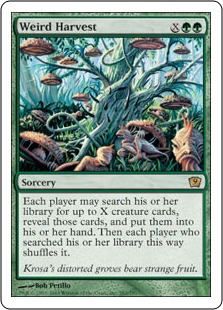
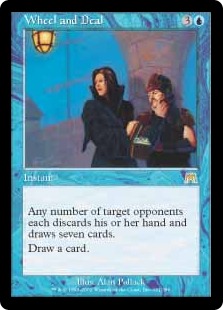
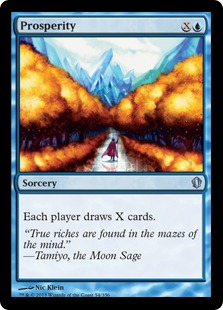
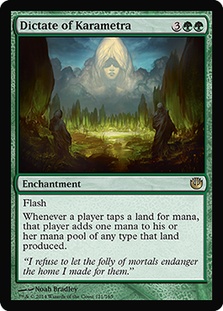
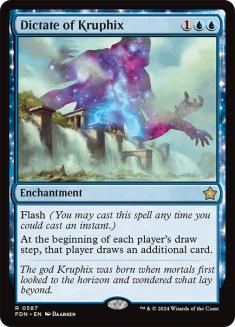
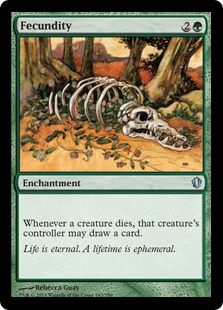
Overall, we need less of this sort of thing – less sharing resources with opponents who are, quite frankly, trying to kill us. Sure, giving people more cards can make games more interesting, but it’s far more likely that they just make you dead. As a general rule, if you cast Weird Harvest for X=2 or greater and then pass the turn, you should honestly expect to die before you get another turn. This deck really isn’t using the multi-tutor in a beneficial way (… and because it’s a multi-tutor, you could argue there really is no beneficial way to use it in Commander…), and it’s exceptional at turning on creature-based two-card combos, so letting each and every single opponent tutor for multiple cards at the same time is a great way to end the game – and not in your brother’s favor.
These can sort of make fun things happen, but it’s far more likely that they just won’t do that, and they’ll make an opponent too big to stop.
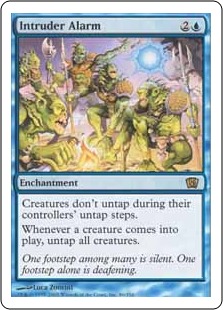
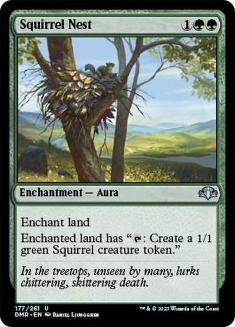
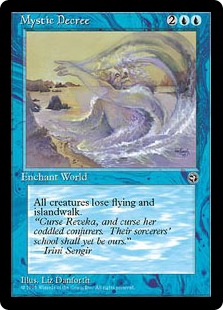
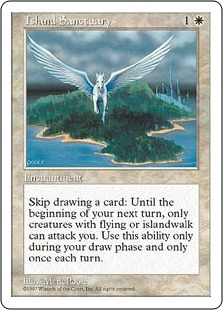

Intruder Alarm and Squirrel Nest are each only present for their combo value and have basically no value themselves out of that context. Intruder Alarm could maybe be interesting, but in actual practice it’s likely not; it’s just going to turn on powerful reusable effects in a way that is presently unforeseeable but which I anticipate will end badly more often than it ends well. If a Fog effect is what you’re looking for, your brother can do far better than actual-Fog, and Island Sanctuary seems like it’s only present for the political effect of the card because of the two-card combo with Mystic Decree – but we can do better than these sorts of pillow-fort enchantments if we want to stop our opponents from being able to attack us.
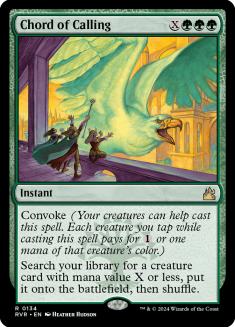
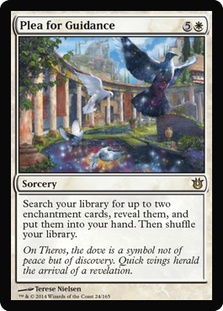
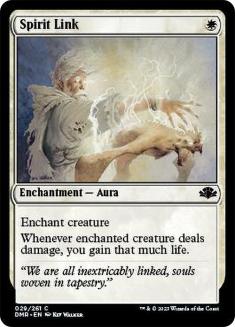
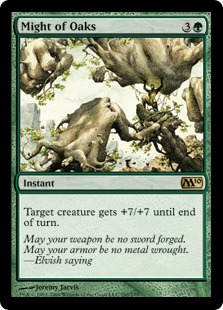
What does Might of Oaks even accomplish in a deck like this? I have to assume it’s present because of the giant squirrel art, and/or the “guess where I’m gonna plant it!” pun, depending on which version of the card we’re talking about. Spirit Link is just derping around, it would be better off as Spirit Loop if that effect was actually wanted – add one mana, and it becomes a “buyback” enchantment like Rancor instead of a single-use buff – or upgraded to Loxodon Warhammer in order to really augment its impact. Instead, I doubt we want anything actually like this effect, so it’s just getting cut. And for the king of derping around, that title goes to Beacon of Immortality – we can do far better than trying to gain life for fun and profit, and my general experience is that that never works anyway. The last two cuts are of unreliable tutors – there’s not much benefit or value to Chord of Calling here, and what little benefit there was to Plea for Guidance disappears thanks to my cuts above taking out most of the enchantment-based combos within the deck.

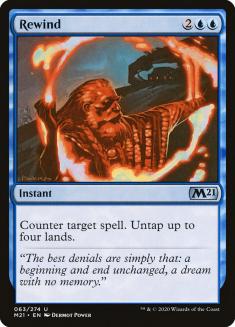
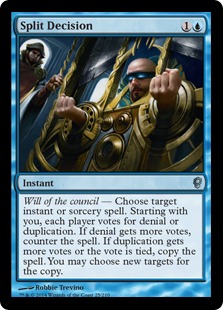
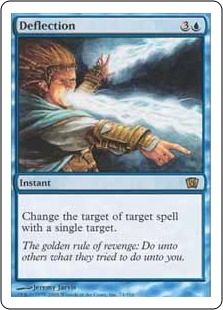
Unreliable countermagic is bad, and so is Silence – much of the same impact could be had by upgrading to Abeyance, which would add the words “draw a card” to this otherwise highly-situational effect – but frankly I don’t think any of that is what this deck is trying to accomplish. Split Decision has a political effect that is better on paper than in actual practice since most people will just want it to be a counterspell, and thus it will generally default to that state instead of adding any tension between the counter vs. duplication aspect of the card.
As we go to add things back in, I’m going to leave seven of these slots blank – we’re going to need to re-balance the deck in order to actually close out a game, and this will give us enough room to add in some finishers. That leaves us room for thirteen additions, which we’ll use as such:
In:
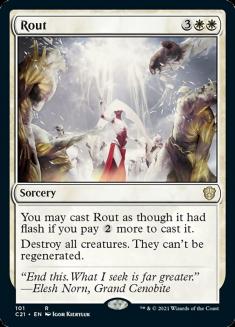
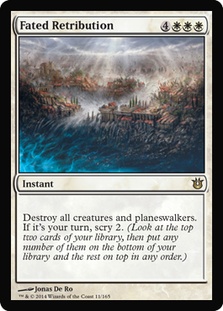
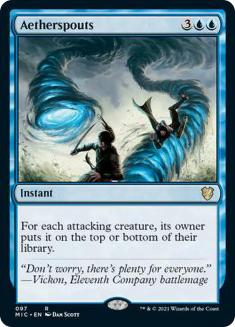
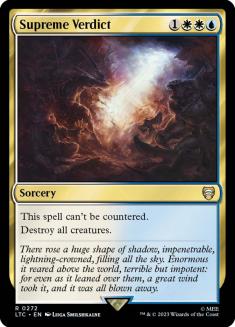
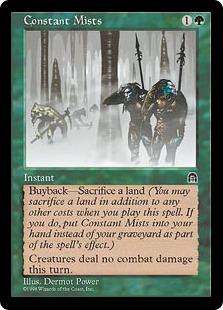
If you’re going for a Fog effect, one mana adds buyback via Constant Mists – and a Fog with buyback can be quite a difficult card to overcome for your average Commander deck, as only one color really has access to countermagic, and most Commander decks rely on combat damage to finish a game. Sure, there are exceptions, but this card can be really tricky to get around and is the strongest “pillow fort” effect I can think of to stop you from losing the game. The other four are straight-up mass removal effects – it’s better to be able to wipe the board than it is to try and manage what is able to actually get through and hit you, so having plenty of cards that play at instant speed and can take down an over-developed board is key to surviving in the later stages of a Commander game.
Supreme Verdict could be Day of Judgment instead, but I figured the little bit of extra investment might be worthwhile against opponents who wanted to be able to stop you from wiping their board. With more money to spend, I’d seek to upgrade this to Austere Command and get the added flexibility that comes with the plethora of options on that card, but coming in light on the budget seemed key so I shied away from expensive cards that weren’t themselves incredibly fun. That money seemed better spent here:
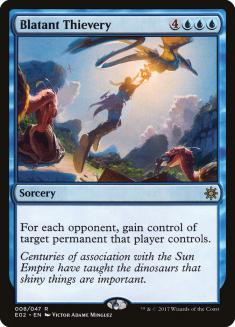
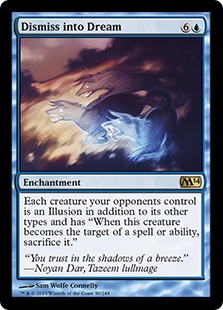
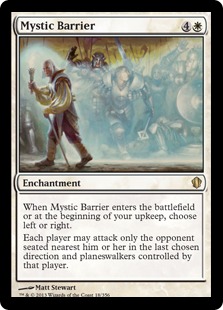
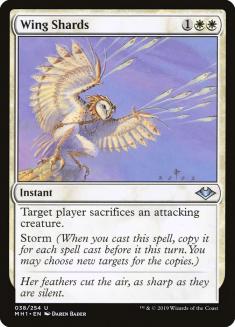
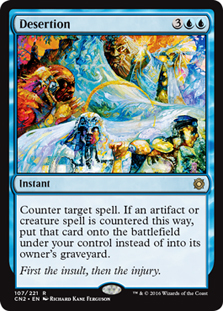
Blatant Thievery is the most expensive card I added to the deck, and it’s here because it’s downright fun. Too many “steal all of the things!” cards become boring very quickly, but with just a few of them (and minimal tutor power) it’ll still be fun every time it comes up – and it should massively turn those games around. Negating each of your opponents’ best threats and gaining three top threats of your own is a huge haymaker to throw in this format, and this deck needs a few more big plays if it’s going to be able to turn the corner and win the game.
The other additions are here to make things more interesting and keep people on their toes. Dismiss into Dream effectively nullifies all equipment cards, which people tend to like to over-use in this format, and it also makes it much harder for them to keep any particular creature in play. Enchantment-heavy Commander decks like Uril, the Miststalker find themselves completely negated with it in play, and cards like Maze of Ith or Mystifying Maze gain an entirely different character when they kill rather than block an opposing attacker. Mystic Barrier lets you choose which opponent is actually allowed to kill you, so you can protect yourself only against the least-developed of the two players seated next to you rather than having to potentially hold off three opponents who decide it’s time to tumble your pillow fort… it’s an oft-forgotten card from an oddball product, but it fits right in here.
Wing Shards is “just” strong removal, but we aren’t counting it as a Wrath because it generally won’t be one – and like Aetherspouts, you can do interesting and political things with it if you try since it doesn’t care whether you are getting attacked, just that someone is attacking. Involving yourself in other peoples’ fights can be all sorts of interesting, and the fact that it can potentially scale in impressive fashion during very busy turns will let it be an unexpected turn of events every once in a while. And Desertion costs just one more mana than the Rewind we cut, with huge benefits for that extra mana spent. This doesn’t look like a deck that wants to be very heavy on the counterspells, but this upgrade is well worth the cost it asks of the deck’s budget.
We have three slots left to fill, and I think what we’re lacking here is some powerful card drawing to keep things going as the game gets longer:
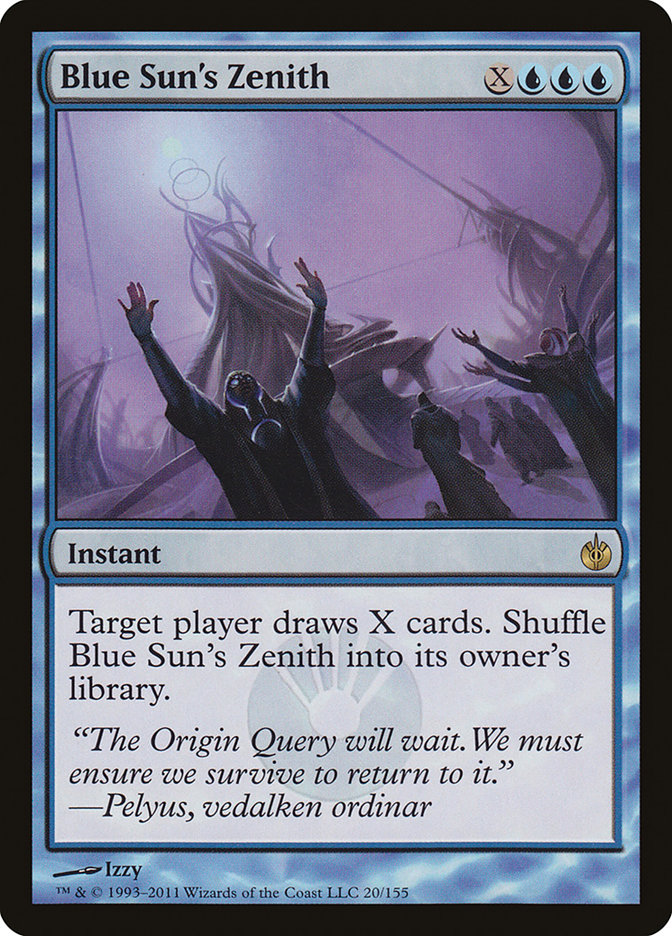
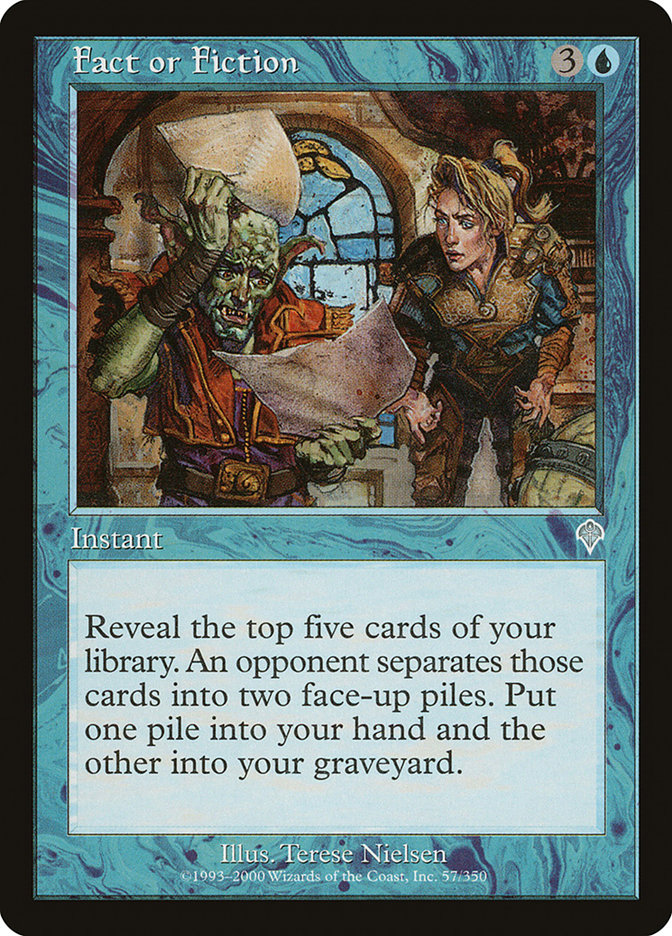
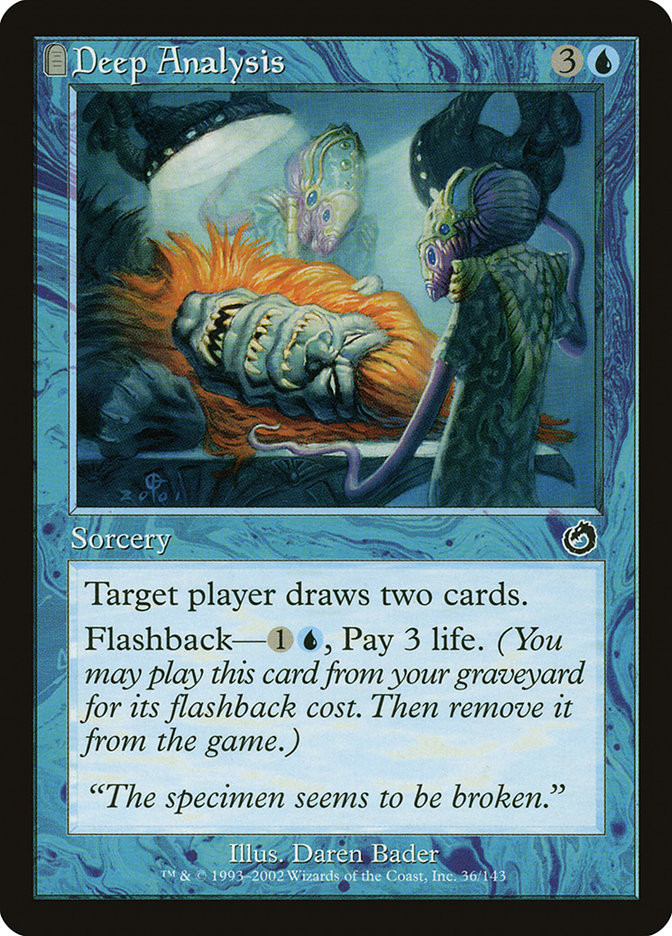
I cut all of the mass card-draw effects that had been in the deck because they helped our opponents at least as much as they helped us, but that left us without much in the way of card drawing at all. We really do want to be able to draw some cards from time to time, and these hit the sweet spot of price versus effectiveness very well. You could go for Mind Spring over Blue Sun’s Zenith and get an extra card for the amount of mana you want to spend on it, but I like both the instant speed that Blue Sun’s Zenith adds here and the shuffle-back-in effect, which makes it more interesting to me than the easier-to-cast Stroke of Genius. When you don’t actually have that many card advantage effects, the potential to draw one a second time is actually pretty intriguing, and I’ve been happy with Blue Sun’s Zenith every time I’ve tried it out in similar situations.
That leaves us one section left to change around, the creature base – which I have held seven empty slots for in order to fill out the deck’s finishers. But first, we have three more cuts to make – Noble Benefactor, Magus of the Moat, and Ghosts of the Innocent. The Benefactor gets cut because, well, its effect will be of greater benefit to your opponents than it ever could to you. It gets cut for the same general reason that Weird Harvest needed trimming. Magus of the Moat is just too unreliable – you’d likely have a more reliable effect trying to use Teferi’s Moat instead, even though that probably only holds back at best half of the creatures on the table, at least it doesn’t die to random creature removal spells when an opponent is ready to attack you. Ghosts of the Innocent is just another pillow-fort type of card that we’d be better off without; by the time you’re able to cast a seven-mana creature you can do far better than this at keeping opposing creatures off your back.
With ten slots to fill, we’re going to add the following:
In:
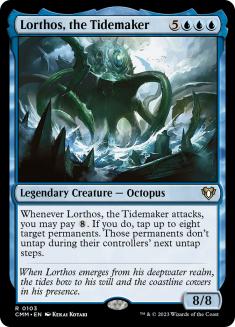
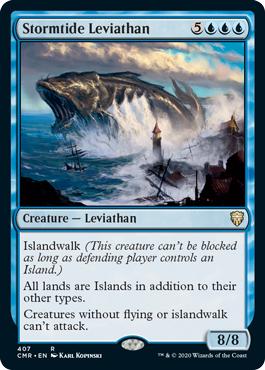
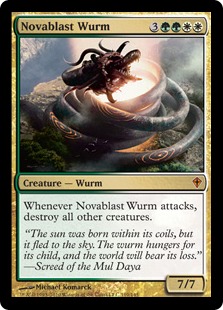
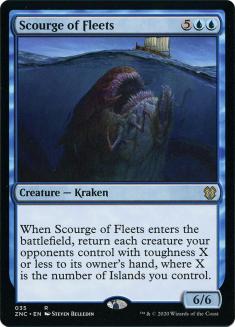
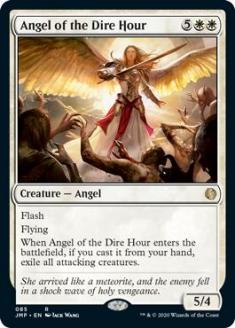
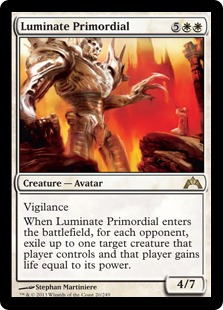
First you laugh at Lorthos, because let’s be honest – Legendary Octopus. Then Lorthos attacks and holds down an entire board’s worth of permanents, potentially crippling any effective blockers or shutting down a player’s counterattack. Killing someone with Lorthos is at least as squee-worthy as an arbitrarily-large number of Squirrels gnawing them to death, and it’s one of those really potent heavy hitters that we are prone to forgetting because nobody ever took it seriously. Novablast Wurm is the same way – it’s tragically underplayed, possibly because green/white decks tend to want to focus on their own hordes of creatures, and thus, generally avoid anything that would take their swarms off the board. But it’s effectively unblockable – go ahead and think about it – and it is really hard for opponents to overcome, letting it really dominate a table given time.
Stormtide Leviathan is the Moat effect you were looking for, I suspect, and we’re playing it over the Island Sanctuary slot that I’d cut since it always has that effect. (I still don’t want to one-two someone with this and a Homelands Enchant World card, but as far as finishers go, I’ll take a bit of extra defense and unblockability on the same card.) Scourge of Fleets is kind of kitschy, but it helps keep opposing creatures under control while we try to give us enough room to win the game, so I approve of trying to put it to work here even though its effect is likely limited to two or three toughness in your average game. That’s still enough to overwhelm token hordes and keep our opponents off balance, letting it effectively counteract the token-granting powers of your other cards if for some reason that becomes inconvenient later on.
The last two – Angel of the Dire Hour and Luminate Primordial – are just strong removal effects attached to useful creatures. We need both more removal and better bodies to try and close a game out with, so both of these should help keep opponents from killing us and up our clock at the same time.
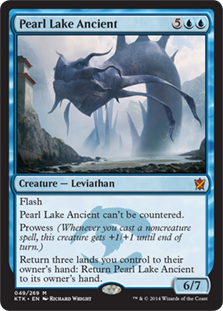
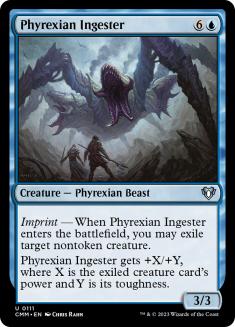
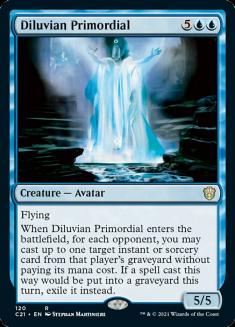
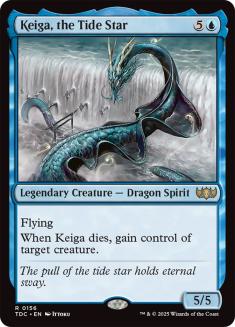
More finishers, with different benefits and advantages to each. Diluvian Primordial is incredibly strong in Commander, to the point where I generally like to say that if I’m casting it, I’ve probably won off of it–hijacking three spells is a huge effect and tends to involve major board swings if we’re timing its use right. Keiga is just a strong finisher that doesn’t really care if our opponents have removal for it, because killing our Dragon lets us steal the best creature in play and use that as our threat instead… and Phyrexian Ingester is a better Duplicant for our purposes, as it will have that Duplicant’s base stats but +3/+3 on top besides. Big threats and solid removal are key here, and we need a critical mass of cards that can actually threaten our opponent with doom if we want to finally have some of them stick.
Pearl Lake Ancient is great in this regard, as it’s very easy to protect from opposing removal so long as we just wait till late enough in the game before putting it to work. Being able to play at instant speed is great here because we’re trying to play more of our cards on opponents’ turns anyway, and it’s a good mix of size, price, and resilience that should let your brother take down opponents and finish the game with a win a little more often. Derping around may be fun, but turning sideways and attacking is even more fun than that.
Putting it all together, we get the following:
Creatures (23)
- 1 Willbender
- 1 Keiga, the Tide Star
- 1 Windborn Muse
- 1 Phelddagrif
- 1 Questing Phelddagrif
- 1 Hunted Lammasu
- 1 Hunted Phantasm
- 1 Hunted Troll
- 1 Arbiter of Knollridge
- 1 Gwafa Hazid, Profiteer
- 1 Lorthos, the Tidemaker
- 1 Novablast Wurm
- 1 Terastodon
- 1 Stormtide Leviathan
- 1 Phyrexian Ingester
- 1 Diluvian Primordial
- 1 Luminate Primordial
- 1 Prophet of Kruphix
- 1 Scourge of Fleets
- 1 Selvala, Explorer Returned
- 1 Clever Impersonator
- 1 Pearl Lake Ancient
- 1 Angel of the Dire Hour
Planeswalkers (1)
Lands (20)
- 1 Temple of the False God
- 1 Krosan Verge
- 1 Selesnya Sanctuary
- 1 Azorius Chancery
- 1 Simic Growth Chamber
- 1 Terramorphic Expanse
- 1 Bant Panorama
- 1 Seaside Citadel
- 1 Graypelt Refuge
- 1 Sejiri Refuge
- 1 Evolving Wilds
- 1 Mystifying Maze
- 1 Alchemist's Refuge
- 1 Azorius Guildgate
- 1 Selesnya Guildgate
- 1 Simic Guildgate
- 1 Tranquil Cove
- 1 Thornwood Falls
- 1 Blossoming Sands
- 1 Myriad Landscape
Spells (56)
- 3 Forest
- 1 Counterspell
- 5 Plains
- 1 Time Stop
- 8 Island
- 1 Capsize
- 1 Constant Mists
- 1 Standstill
- 1 Wing Shards
- 1 Desertion
- 1 Second Sunrise
- 1 Arcane Denial
- 1 Gate to the Aether
- 1 Oblation
- 1 Blatant Thievery
- 1 Aurification
- 1 Reparations
- 1 Reins of Power
- 1 Oath of Lieges
- 1 Lifeline
- 1 Rout
- 1 Fact or Fiction
- 1 Bind
- 1 Cultural Exchange
- 1 Deep Analysis
- 1 Selesnya Signet
- 1 Azorius Signet
- 1 Simic Signet
- 1 Rites of Flourishing
- 1 Gather Specimens
- 1 Hive Mind
- 1 Planar Cleansing
- 1 Mimic Vat
- 1 Blue Sun's Zenith
- 1 Command Tower
- 1 Supreme Verdict
- 1 Dismiss into Dream
- 1 Mystic Barrier
- 1 Tempt with Discovery
- 1 Fated Retribution
- 1 Coercive Portal
- 1 Aetherspouts
- 1 Sylvan Offering

As always, for participating in this week’s edition, you’ll be receiving a $20 coupon to the StarCityGames.com Online Store, and since we’ve kept to a very tight budget here – overall, these thirty changes cost just $36.74 – it will be very easy for you and your brother to make these changes with just a little bit of extra investment on top of that coupon. Pricing things out individually, our changes cost the following:
| Selesnya Guildgate | 0.15 |
| Simic Guildgate | 0.15 |
| Diluvian Primordial | 0.25 |
| Luminate Primordial | 0.25 |
| Fated Retribution | 0.25 |
| Stormtide Leviathan | 0.25 |
| Phyrexian Ingester | 0.25 |
| Scourge of Fleets | 0.25 |
| Dismiss Into Dream | 0.25 |
| Mystic Barrier | 0.25 |
| Deep Analysis | 0.29 |
| Wing Shards | 0.29 |
| Alchemist’s Refuge | 0.3 |
| Aetherspouts | 0.33 |
| Krosan Verge | 0.39 |
| Graypelt Refuge | 0.45 |
| Blue Sun’s Zenith | 0.45 |
| Fact or Fiction | 0.69 |
| Constant Mists | 0.79 |
| Mystifying Maze | 1.09 |
| Lorthos, the Tidemaker | 1.27 |
| Rout | 1.29 |
| Pearl Lake Ancient | 1.34 |
| Angel of the Dire Hour | 1.44 |
| Mimic Vat | 2.12 |
| Novablast Wurm | 2.69 |
| Keiga, the Tide Star | 3.29 |
| Supreme Verdict | 3.59 |
| Desertion | 5.49 |
| Blatant Thievery | 6.85 |
We’re coming up on a pretty big anniversary soon – by my count, Dear Azami #200 is in two weeks, and our plan for #100 had been to have Sheldon Menery guest-host for the week, which is a tradition I’m hoping to continue for #200 (but with better planning this time, asking far enough in advance to actually have it happen for the anniversary edition). So next week you can expect to see Jess, but I won’t be here in two weeks… and you’ll just have to wait and see which guest author we’ve lined up this time.
Want to submit a deck for consideration to Dear Azami? We’re always accepting deck submissions to consider for use in a future article, like Aeryn’s Alesha, Who Smiles At Death deck or John’s Wort, Boggart Auntie deck. Only one deck submission will be chosen per article, but being selected for the next edition of Dear Azami includes not just deck advice but also a $20 coupon to StarCityGames.com!
Email us a deck submission using this link here!
Like what you’ve seen? Feel free to explore more of Dear Azami here, in the Article Archives! Feel free to follow Sean on Facebook… sometimes there are extra surprises and bonus content to be found over on his Facebook Fan Page, as well as previews of the next week’s column at the end of the week!
And feel free to check Jess’s own Command of Etiquette column on Hipsters of the Coast for more Commander and casual content!
